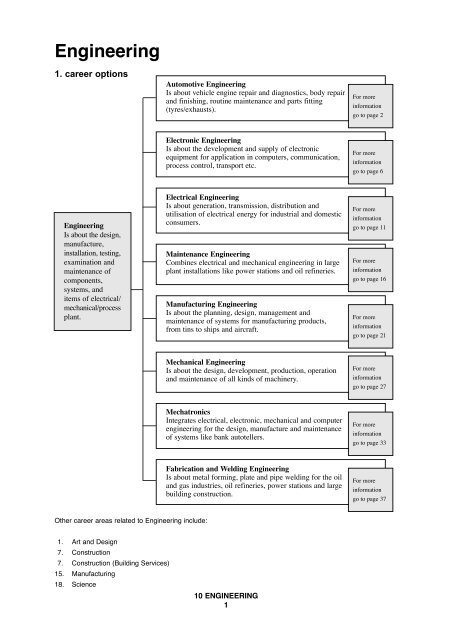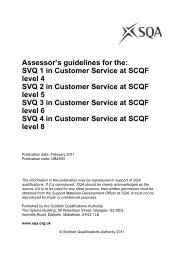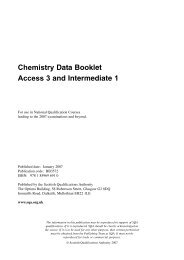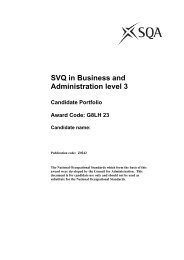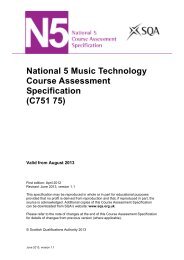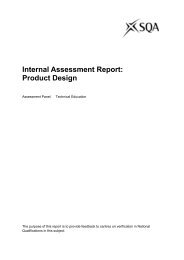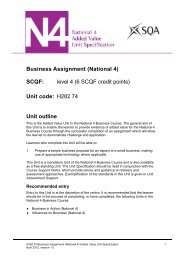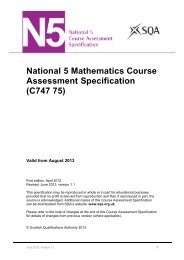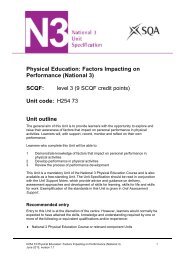Progression Routes June 2#60374 - SQA
Progression Routes June 2#60374 - SQA
Progression Routes June 2#60374 - SQA
You also want an ePaper? Increase the reach of your titles
YUMPU automatically turns print PDFs into web optimized ePapers that Google loves.
Engineering<br />
1. career options<br />
Automotive Engineering<br />
Is about vehicle engine repair and diagnostics, body repair<br />
and finishing, routine maintenance and parts fitting<br />
(tyres/exhausts).<br />
For more<br />
information<br />
go to page 2<br />
Electronic Engineering<br />
Is about the development and supply of electronic<br />
equipment for application in computers, communication,<br />
process control, transport etc.<br />
For more<br />
information<br />
go to page 6<br />
Engineering<br />
Is about the design,<br />
manufacture,<br />
installation, testing,<br />
examination and<br />
maintenance of<br />
components,<br />
systems, and<br />
items of electrical/<br />
mechanical/process<br />
plant.<br />
Electrical Engineering<br />
Is about generation, transmission, distribution and<br />
utilisation of electrical energy for industrial and domestic<br />
consumers.<br />
Maintenance Engineering<br />
Combines electrical and mechanical engineering in large<br />
plant installations like power stations and oil refineries.<br />
Manufacturing Engineering<br />
Is about the planning, design, management and<br />
maintenance of systems for manufacturing products,<br />
from tins to ships and aircraft.<br />
For more<br />
information<br />
go to page 11<br />
For more<br />
information<br />
go to page 16<br />
For more<br />
information<br />
go to page 21<br />
Mechanical Engineering<br />
Is about the design, development, production, operation<br />
and maintenance of all kinds of machinery.<br />
For more<br />
information<br />
go to page 27<br />
Mechatronics<br />
Integrates electrical, electronic, mechanical and computer<br />
engineering for the design, manufacture and maintenance<br />
of systems like bank autotellers.<br />
For more<br />
information<br />
go to page 33<br />
Fabrication and Welding Engineering<br />
Is about metal forming, plate and pipe welding for the oil<br />
and gas industries, oil refineries, power stations and large<br />
building construction.<br />
For more<br />
information<br />
go to page 37<br />
Other career areas related to Engineering include:<br />
1. Art and Design<br />
7. Construction<br />
7. Construction (Building Services)<br />
15. Manufacturing<br />
18. Science<br />
10 ENGINEERING<br />
1
Automotive Engineering<br />
2. jobs and careers<br />
Design Engineer<br />
Is someone who works on the design and<br />
development of engines, braking, suspension<br />
and steering systems etc.<br />
Service Manager<br />
Is someone who supervises groups of mechanics,<br />
scheduling and allocating work; dealing with<br />
customers.<br />
Auto Mechanic/ Vehicle Technician<br />
Is someone who carries out vehicle servicing, fault<br />
diagnosis, fitting accessories, engine tuning and heavy,<br />
light and motorcycle vehicles work.<br />
Automotive<br />
Engineering<br />
Auto-Electrician<br />
Is someone who diagnosis electrical/electronic<br />
faults, fits accessories, intruder alarms, stereos and<br />
mobile phones.<br />
Vehicle Body Repair/Painting Craftsperson<br />
Is someone who carries out accident repairs using<br />
metal and weld-on parts, window replacement and<br />
finishing.<br />
Warehouse Person<br />
Is someone who stores, locates and distributes<br />
vehicle parts often using computer data systems.<br />
Parts Fitter<br />
Is someone who fits standard routine parts to<br />
vehicles, eg tyres, exhausts, breaks linings.<br />
10 ENGINEERING<br />
2
Automotive Engineering<br />
3: qualifications and jobs School, Further and Higher Education Qualification awards Type of job Workbased Award<br />
Design Engineer<br />
SVQ 5<br />
Directing Automative<br />
Maintenance<br />
Degree<br />
BEng<br />
Automotive<br />
Engineering<br />
HND<br />
Automotive Engineering<br />
and Management<br />
Service Manager<br />
SVQ 4<br />
Co-ordinating<br />
Automative<br />
Maintainance<br />
Courses and SGAs at<br />
Advanced Higher Level<br />
HNC<br />
Automotive Engineering<br />
Vehicle Technician<br />
Auto Mechanic<br />
Auto Electrician<br />
SVQ 3<br />
Vehicle Mechanical<br />
and Electronic<br />
Systems:<br />
Maintenance<br />
and Repairs<br />
Standard<br />
Grades<br />
Credit<br />
General<br />
Courses at Higher Level<br />
Courses<br />
at Int 2 Level<br />
Courses<br />
at Int 1 Level<br />
Clusters at Acc 3<br />
School and<br />
College Programmes<br />
of National Units<br />
SGA at Higher Level<br />
Engineering: Automotive<br />
SGA at Int 2 Level<br />
Engineering<br />
Vehicle Body Repair/<br />
Painting Craftsperson<br />
Warehouse Person<br />
Parts Fitter<br />
SVQ 2<br />
Vehicle Maintenance:<br />
Service Replacement<br />
SVQ 1<br />
Vehicle Maintenance:<br />
Service Replacement<br />
Foundation<br />
Clusters at Acc 2<br />
This diagram outlines the main qualifications in the Automotive Engineering area. A full list of all <strong>SQA</strong> qualifications is on the following pages. People can progress vertically<br />
from one qualification to another, eg from a Course at Int 1 to a Course at Int 2. In addition people can progress diagonally from one level of Standard Grade to a higher level<br />
of Course or Scottish Group Award (SGA), eg from Standard Grade at General level to Courses or SGAs at Int 2 level.<br />
In this diagram, SVQs and PDAs in the Vocational sector are placed according to current practice and usage in illustrating the relationships and pathways between qualifications,<br />
jobs and careers.<br />
10 ENGINEERING<br />
3
Automotive Engineering<br />
4. qualifications<br />
HND<br />
Automotive Engineering<br />
Automotive Engineering and Management<br />
HNC<br />
Automotive Engineering<br />
Automotive Management<br />
PDA<br />
Certificate<br />
Motor Vehicle Systems<br />
Motor Vehicle Systems Diagnostics<br />
Motor Vehicle Repair and Body Refinishing<br />
SGA<br />
Higher<br />
Engineering: Automotive Engineering<br />
Int 2<br />
Engineering<br />
National Course<br />
Higher<br />
Automotive Diagnostics<br />
Intermediate 2<br />
Automotive Engineering<br />
NC Group Award<br />
Motor Vehicle Repair and Body Re-finishing<br />
Motor Vehicle Systems<br />
SVQ 5<br />
Directing Automotive Maintenance<br />
SVQ 4<br />
Co-ordinating Automotive Maintenance<br />
SVQ 3<br />
Maintaining Automotive Vehicles: Electrical/Electronic<br />
Maintaining Automotive Vehicles: Mechanical<br />
Motorcycle Mechanical and Electronic Systems: Maintenance and Repair<br />
Vehicle Body Re-finishing<br />
Vehicle Body Repair<br />
Vehicle Mechanical and Electronic Systems: Maintenance and Repair: Heavy Vehicle<br />
Vehicle Mechanical and Electronic Systems: Maintenance and Repair: Light Vehicle<br />
SVQ 2<br />
Maintaining Automotive Vehicles<br />
Maintaining Automotive Vehicles: Body Structures and Cladding<br />
Vehicle Body Fitting<br />
Vehicle Maintenance: Service Replacement<br />
Vehicle Mechanical and Electronic System Unit Replacement: Light Vehicle<br />
SVQ 1<br />
Maintaining Automotive Vehicles<br />
Vehicle Maintenance: Service Replacement<br />
10 ENGINEERING<br />
4
Automotive Engineering<br />
5. notes on entry to jobs and careers<br />
Entry routes<br />
◆<br />
◆<br />
◆<br />
School leavers — could enter FE courses at National Certificate or Higher National Certificate depending<br />
on school qualifications.<br />
Direct entry into employment — it is possible to obtain employment before or after FE courses.<br />
Adult entry — mature entrants would normally enter a National Certificate programme; a bridging course<br />
may be necessary depending on qualifications and experience.<br />
SVQ access<br />
SVQs are normally workbased and obtained after or during FE courses.<br />
Entry requirements<br />
◆<br />
◆<br />
◆<br />
◆<br />
For some jobs listed no formal qualifications will be required.<br />
Entry to an SGA ranges from no formal qualifications to two Standard Grades.Science and Technology<br />
subjects are important.<br />
HNCs/HNDs will normally require an appropriate SGA or one or two Highers, plus 3 to four Standard<br />
Grades, including English and Maths.<br />
Degree courses will usually require three or four Highers including Maths and Physics or Technological<br />
Studies plus appropriate Standard Grades; or appropriate HNC/HND.<br />
Note — entry requirements vary between institutions. Check prospectuses before applying.<br />
10 ENGINEERING<br />
5
Electronic Engineering<br />
2. jobs and careers<br />
Chartered Engineer<br />
Is someone who carries out the design, development<br />
and manufacture of electronic equipment and<br />
systems for many applications, eg computers,<br />
communication.<br />
Incorporated Engineer<br />
Is someone who plans and controls large electronic<br />
control equipment and systems, supervises craft<br />
and technician staff.<br />
Electronic<br />
Engineering<br />
Electronic Technician<br />
Is someone who installs electronic equipment<br />
and systems, carries out fault diagnosis and repairs<br />
and tests and reports on system condition.<br />
Electronic Assembly Worker/Setter<br />
Is someone who mounts components on printed<br />
circuit boards, carries out routine maintenance<br />
and checks and changes systems.<br />
Machine Operator<br />
Is someone who loads and operates machines<br />
for automatic assembly<br />
10 ENGINEERING<br />
6
Electronic Engineering<br />
3: qualifications and jobs School, Further and Higher Education Qualification awards Type of job Workbased Award<br />
Courses and SGAs at<br />
Advanced Higher Level<br />
Degree<br />
BEng/BSc<br />
Electronic<br />
Engineering<br />
B Eng<br />
Electronic<br />
Engineering<br />
with Management<br />
HND<br />
Electronic and Electrical<br />
Engineering<br />
HNC<br />
Electrical Engineering<br />
Electronic and Electrical<br />
Engineering<br />
Chartered Engineer<br />
Incorporated Engineer<br />
Electronic Technician<br />
SVQ 3<br />
Servicing Electronic<br />
Systems<br />
Standard<br />
Grades<br />
Credit<br />
General<br />
Courses at Higher Level<br />
Courses<br />
at Int 2 Level<br />
Courses<br />
at Int 1 Level<br />
Clusters at Acc 3<br />
School and<br />
College Programmes<br />
of National Units<br />
SGAs at Higher Level<br />
Engineering: Electronics<br />
SGA at Int 2 Level<br />
Engineering<br />
SGAs at Int 1 Level<br />
Electronic Assembly<br />
Worker/Setter<br />
Machine Operator<br />
SVQ 2<br />
Servicing Electronic<br />
Systems<br />
SVQ 1<br />
Electronic<br />
Product Assembly<br />
Foundation<br />
Clusters at Acc 2<br />
Skillstart and SGAs<br />
at Acc 2 & Acc 3<br />
This diagram outlines the main qualifications in the Electronic Engineering area. A full list of all <strong>SQA</strong> qualifications is on the following pages. People can progress vertically<br />
from one qualification to another, eg from a Course at Int 1 to a Course at Int 2. In addition people can progress diagonally from one level of Standard Grade to a higher<br />
level of Course or Scottish Group Award (SGA), eg from Standard Grade at General level to Courses or SGAs at Int 2 level.<br />
In this diagram, SVQs and PDAs in the Vocational sector are placed according to current practice and usage in illustrating the relationships and pathways between qualifications,<br />
jobs and careers.<br />
10 ENGINEERING<br />
7
Electronic Engineering<br />
4. qualifications<br />
HND<br />
Audio Engineering<br />
Electronic and Electrical Engineering<br />
Electronic and Electrical Systems<br />
Electronic Engineering<br />
Electronic Systems<br />
Electronics with Music Technology<br />
Engineering: Computer Technology<br />
Engineering: Electronics<br />
Engineering: Electronic Manufacture<br />
Engineering: Telecommunications<br />
HNC<br />
Audio Engineering<br />
Electronic and Electrical Engineering<br />
Electronics<br />
Engineering: Electronics<br />
Engineering: Electronic Manufacture<br />
Engineering: Practice<br />
Engineering: Telecommunications<br />
Television and Audio Visual Media Engineering<br />
PDA<br />
Adv Certificate<br />
Engineering Practice: Electromechanical<br />
SGA<br />
Higher<br />
Engineering: Electronics<br />
Int 2<br />
Engineering<br />
GSVQ III<br />
Engineering: Electronic and Electrical<br />
Engineering: Practice<br />
Technology<br />
GSVQ II<br />
Engineering<br />
Technology<br />
National Course<br />
Adv Higher<br />
Electronics<br />
Higher<br />
Electronics<br />
Process Control<br />
Process Measurement<br />
Telecommunications<br />
Int 2<br />
Electronic and Electrical Fundamentals<br />
Int 1<br />
Applied Practical Electronics<br />
NC Group Award<br />
Electronic Engineering<br />
Electronic Engineering Practice<br />
10 ENGINEERING<br />
8
SVQ 3<br />
Operating and Maintaining the Performance of Telecommunications Equipment<br />
Repair Cellular Terminal Equipment<br />
Servicing Electronic Systems (Field)<br />
Servicing Electronic Systems (Workshop)<br />
Servicing Software (Support Centre) or (Field)<br />
SVQ 2<br />
Electronic Product Assembly and Rectification<br />
Installing and Maintaining Aerial Equipment and Associated Feeders<br />
Performing Engineering Operations<br />
Printed Circuit Board Assembly and Repair<br />
Servicing Electronic Systems (Field)<br />
Servicing Electronic Systems (Workshop)<br />
Servicing Software (Support Centre)<br />
SVQ 1<br />
Electronic Product Assembly<br />
Installing Fibre Optic Communications Links<br />
Printed Circuit Board Assembly<br />
Surface Mount Technology and Automatic Assembly and Repair<br />
10 ENGINEERING<br />
9
Electronic Engineering<br />
5. notes on entry to jobs and careers<br />
Entry routes<br />
◆<br />
◆<br />
◆<br />
School leavers — could enter FE courses at NC, HNC, HND level or HE courses at degree level<br />
depending on school qualifications.<br />
Direct entry into employment — is possible before or after FE or HE courses.<br />
Adult entry — mature entrants would normally enter a National Certificate programme;<br />
a bridging course may be necessary depending on qualifications and experience.<br />
SVQ access<br />
SVQs are normally workbased and obtained after or during FE or HE courses.<br />
The Professional Qualifications of Technician, Incorporated Engineer and Chartered Engineer are awarded<br />
by the Engineering Council. In addition to appropriate academic qualifications candidates must have work<br />
experience and undertake further work-based training and awards. They must also hold an appropriate post<br />
of responsibility.<br />
Entry requirements<br />
◆<br />
◆<br />
◆<br />
◆<br />
Some jobs require no formal qualifications<br />
Entry to an SGA ranges from no formal qualifications to three or four Standard Grades. Useful subjects<br />
include English, Maths, Physics, Technological Studies, Craft and Design, Computing<br />
HNCs/HNDs require an appropriate SGA or two Highers and three Standard Grades including Maths,<br />
Physics or Technological Studies<br />
Degree courses will usually require three or four Highers including Maths and Physics or Technological<br />
Studies and Standard Grades; or appropriate HNC/HND.<br />
Note — entry requirements vary between institutions. Check prospectuses before applying.<br />
10 ENGINEERING<br />
10
Electrical Engineering<br />
2. jobs and careers<br />
Chartered Engineer<br />
Is someone who designs, develops and manages the<br />
electrical plant and equipment.<br />
Incorporated Engineer<br />
Is someone who plans and controls all plant and<br />
equipment operation, directs and supervises craft<br />
and technician staff.<br />
Electrical<br />
Engineering<br />
Electrical Technician<br />
Is someone who supervises craft electricians<br />
carrying out installation, testing and machine<br />
maintenance of electrical plant and equipment.<br />
Craft Electrician<br />
Is someone who carries out routine maintenance<br />
of electrical plant and installs and tests plant<br />
equipment under supervision.<br />
Operative<br />
Is someone who operates machinery under<br />
supervision.<br />
10 ENGINEERING<br />
11
Electrical Engineering<br />
3: qualifications and jobs School, Further and Higher Education Qualification awards Type of job Workbased Award<br />
Degree<br />
Chartered Engineer<br />
Courses and SGAs at<br />
Advanced Higher Level<br />
BEng/BSc<br />
Electrical Power<br />
Engineering<br />
B Eng<br />
Engineering<br />
HND<br />
Electronic and<br />
Electrical Engineering<br />
HNC<br />
Electronic and<br />
Electrical Engineering<br />
Incorporated Engineer<br />
Electrical Technician<br />
SVQ 3<br />
Engineering<br />
Maintenance<br />
Standard<br />
Grades<br />
Credit<br />
General<br />
Foundation<br />
Courses at Higher Level<br />
Courses<br />
at Int 2 Level<br />
Courses<br />
at Int 1 Level<br />
Clusters at Acc 3<br />
Clusters at Acc 2<br />
School and<br />
College Programmes<br />
of National Units<br />
SGAs at Higher Level<br />
Engineering: Electrical<br />
SGAs at Int 2 Level<br />
Engineering<br />
Craft Electrician<br />
Operative<br />
SVQ 2<br />
Engineering<br />
Maintenance<br />
SVQ 1<br />
Processing<br />
Engineering<br />
Maintenance<br />
This diagram outlines the main qualifications in the Electrical Engineering area. A full list of all <strong>SQA</strong> qualifications is on the following pages. People can progress vertically<br />
from one qualification to another, eg from a Course at Int 1 to a Course at Int 2. In addition people can progress diagonally from one level of Standard Grade to a higher<br />
level of Course or Scottish Group Award (SGA), eg from Standard Grade at General level to Courses or SGAs at Int 2 level.<br />
In this diagram, SVQs and PDAs in the Vocational sector are placed according to current practice and usage in illustrating the relationships and pathways between qualifications,<br />
jobs and careers.<br />
10 ENGINEERING<br />
12
Electrical Engineering<br />
4. qualifications<br />
HND<br />
Electronic and Electrical Engineering<br />
Engineering: Electrical<br />
HNC<br />
Electrical Engineering<br />
Electronic and Electrical Engineering<br />
Engineering: Electrical<br />
Engineering: Practice<br />
Instrumentation<br />
Measurement and Control Engineering<br />
Process Control<br />
SGA<br />
Higher<br />
Engineering: Electrical<br />
Int 2<br />
Engineering<br />
GSVQ III<br />
Engineering: Electronic and Electrical<br />
Engineering: Practice<br />
Technology<br />
GSVQ II<br />
Engineering<br />
Technology<br />
National Course<br />
Higher<br />
Electrical<br />
Int 2<br />
Electronic and Electrical Fundamentals<br />
Electrical Installation Fundamentals<br />
NC Group Award<br />
Electrical Engineering<br />
Electrical Engineering Practice<br />
SVQ 3<br />
Engineering Construction: Maintaining Electrical Systems of Plant and Equipment<br />
Engineering Construction: Maintaining Instrument and Control Systems of Plant and Equipment<br />
Engineering Maintenance<br />
Engineering Technical Services<br />
Erecting and Maintaining Steel Tower Overhead Lines<br />
Erecting and Maintaining Wood Pole Overhead Lines<br />
Install and Commission Machinery and Equipment<br />
Installing and Commissioning Electrical Systems and Equipment and Maintenance<br />
Installing and Maintaining Electrical Transmission Substation Plant and Apparatus<br />
Installing and Maintaining Electricity Substation Plant and Apparatus<br />
Jointing and Terminating Distribution and Transmission Cables<br />
Maintaining Electricity Generation Systems<br />
Operating Multiple Electricity Generation Systems<br />
Process Engineering Maintenance<br />
10 ENGINEERING<br />
13
SVQ 2<br />
Engineering Maintenance<br />
Installing Electrical Systems and Equipment<br />
Maintaining Electricity Generation Systems<br />
Maintaining Security and Emergency Systems<br />
Operating Single Electricity Generation Systems<br />
Performing Engineering Operations<br />
Process Engineering Maintenance<br />
Specifying Security and Emergency Systems<br />
SVQ 1<br />
Cabling and Wiring Loom Manufacture<br />
Fix Cable Supports<br />
Fixing Cable<br />
Processing Engineering Maintenance<br />
10 ENGINEERING<br />
14
Electrical Engineering<br />
5. notes on entry to jobs and careers<br />
Entry routes<br />
◆<br />
◆<br />
◆<br />
School leavers — could enter FE courses at NC, HNC, HND level or HE courses at degree level depending<br />
on school qualifications.<br />
Direct entry into employment — is possible before or after FE or HE courses.<br />
Adult entry — mature entrants would normally enter a National Certificate programme; a bridging<br />
course may be necessary depending on qualifications and experience.<br />
SVQ access<br />
SVQs are normally work-based and obtained after or during FE or HE courses.<br />
The Professional Qualifications of Technician, Incorporated Engineer and Chartered Engineer are awarded by<br />
the Engineering Council. In addition to appropriate academic qualifications candidates must have work<br />
experience and undertake further work-based training and awards. They must also hold an appropriate post<br />
of responsibility.<br />
Entry requirements<br />
◆<br />
◆<br />
◆<br />
◆<br />
Entry to some jobs is possible with no formal qualifications<br />
Entry to an SGA ranges from no formal qualifications to three or four Standard Grades. Useful subjects<br />
include English, Maths, Physics, Science, Technological Studies, Craft and Design, Computing<br />
HNCs/HNDs will require an appropriate SGA or two Highers and three Standard Grades including Maths,<br />
Physics or Technological Studies<br />
Degree courses will usually require three or four Highers including Maths and Physics or Technological<br />
Studies and appropriate Standard Grades; or appropriate HNC/HND.<br />
Note — entry requirements vary between institutions. Check prospectuses before applying.<br />
10 ENGINEERING<br />
15
Maintenance Engineering<br />
2. jobs and careers<br />
Chartered Engineer<br />
Is someone who designs, develops and manages the<br />
manufacture of electrical and mechanical plant and<br />
equipment and directs engineering and technician<br />
support staff.<br />
Incorporated Engineer<br />
Is someone who controls all electrical and<br />
mechanical plant operations and supervises craft<br />
and technician staff carrying out design, planning<br />
and control operations.<br />
Maintenance<br />
Engineering<br />
Multi-skilled Technician<br />
Is someone who carries out acceptance tests, fault<br />
diagnosis and repair of electrical and mechanical<br />
plant and equipment and installation, testing and<br />
routine maintenance.<br />
Multi-skilled Craftsperson<br />
Is someone who installs and tests electrical and<br />
mechanical plant and equipment and carries out<br />
routine maintenance of plant and equipment<br />
components under supervision.<br />
Operative<br />
Is someone who operates machinery under<br />
supervision.<br />
10 ENGINEERING<br />
16
Maintenance Engineering<br />
3: qualifications and jobs School, Further and Higher Education Qualification awards Type of job Workbased Award<br />
Degree<br />
Chartered Engineer<br />
Courses and SGAs at<br />
Advanced Higher Level<br />
BEng/BSc<br />
Electronic<br />
Engineering<br />
B Eng<br />
Electronic<br />
Engineering<br />
with<br />
Management<br />
HND<br />
Computer Aided<br />
Engineering<br />
HNC<br />
Multi-Disciplinary<br />
Engineering<br />
Incorporated Engineer<br />
Multi-skilled Technician<br />
Multi-skilled<br />
Craftsperson<br />
SVQ 3<br />
Engineering<br />
Assembly<br />
Standard<br />
Grades<br />
Credit<br />
General<br />
Courses at Higher Level<br />
Courses at<br />
Int 2 Level<br />
Courses at<br />
Int 1 Level<br />
Clusters at Acc 3<br />
School and<br />
College Programmes<br />
of National Units<br />
SGA at Higher Level<br />
Engineering:<br />
Industrial Plant Support<br />
SGA at Int 2 Level<br />
Engineering<br />
SGAs at Int 1 Level<br />
Operative<br />
SVQ 2<br />
Engineering<br />
Maintenance<br />
SVQ 1<br />
Engineering<br />
Maintenance<br />
Foundation<br />
Clusters at Acc 2<br />
Skillstart and SGAs<br />
at Acc 2 & Acc 3<br />
This diagram outlines the main qualifications in the Maintenance Engineering area. A full list of all <strong>SQA</strong> qualifications is on the following pages. People can progress<br />
vertically from one qualification to another, eg from a Course at Int 1 to a Course at Int 2. In addition people can progress diagonally from one level of Standard Grade<br />
to a higher level of Course or Scottish Group Award (SGA), eg from Standard Grade at General level to Courses or SGAs at Int 2 level.<br />
In this diagram, SVQs and PDAs in the Vocational sector are placed according to current practice and usage in illustrating the relationships and pathways between qualifications,<br />
jobs and careers.<br />
10 ENGINEERING<br />
17
Maintenance Engineering<br />
4. qualifications<br />
HND<br />
Computer Aided Engineering<br />
Engineering: Service Engineering<br />
Integrated Engineering and Manufacture<br />
Measurement and Control Engineering<br />
Service Engineering: Agriculture, Horticulture and Construction Plant<br />
HNC<br />
Building Services Plant Engineering<br />
Multi-disciplinary Engineering<br />
Service Engineering: Agriculture, Horticulture and Construction Plant<br />
PDA<br />
Adv Certificate<br />
Engineering Practice: Manufacture and Engineering Support<br />
SGA<br />
Higher<br />
Engineering: Industrial Plant Support<br />
Int 2<br />
Engineering<br />
GSVQ III<br />
Engineering: Industrial Plant Support<br />
GSVQ II<br />
Engineering<br />
NC Group Award<br />
Electrical Engineering<br />
Engineering<br />
Electrical Engineering Practice<br />
Engineering Practice<br />
Measurement and Control<br />
National Course<br />
Higher<br />
Industial Plant Support<br />
SVQ 3<br />
Co-ordinate the Provision of Servicing Activities<br />
Engineering Assembly<br />
Engineering Construction: Installing Pipework Systems<br />
Engineering Construction: Maintaining Electrical Systems of Plant and Equipment<br />
Engineering Construction: Maintaining Instrument and Control Systems of Plant and Equipment<br />
Engineering Construction: Maintaining Mechanical Systems of Plant and Equipment<br />
Engineering Construction: Project Control<br />
Engineering Maintenance<br />
Engineering Technical Services<br />
Install and Commission Machinery and Equipment<br />
Process Engineering Maintenance<br />
Textile Technician<br />
10 ENGINEERING<br />
18
SVQ 2<br />
Engineering Maintenance<br />
Install and Commission Machinery and Equipment<br />
Performing Engineering Operations<br />
Process Engineering Maintenance<br />
SVQ 1<br />
Engineering Assembly<br />
Engineering Maintenance<br />
Process Engineering Maintenance<br />
10 ENGINEERING<br />
19
Maintenance Engineering<br />
5. notes on entry to jobs and careers<br />
Entry routes<br />
◆<br />
◆<br />
◆<br />
School leavers — could enter FE courses at NC, HNC, HND level or HE courses at degree level depending<br />
on school qualifications.<br />
Direct entry into employment — is possible before or after FE or HE courses.<br />
Adult entry — mature entrants would normally enter a National Certificate programme; a bridging course<br />
may be necessary depending on qualifications and experience.<br />
SVQ access<br />
SVQs are normally work-based and obtained after or during FE or HE courses.<br />
The Professional Qualifications of Technician, Incorporated Engineer and Chartered Engineer are awarded<br />
by the Engineering Council. In addition to appropriate academic qualifications candidates must have work<br />
experience and undertake further work-based training and awards. They must also hold an appropriate post<br />
of responsibility.<br />
Entry requirements<br />
◆<br />
◆<br />
◆<br />
◆<br />
Entry to some jobs is possible with no formal qualifications<br />
Entry to an SGA ranges from no formal qualifications to three or four Standard Grades. Useful subjects<br />
include English, Maths, Physics, Science, Technological Studies, Craft and Design, Computing<br />
HNCs/HNDs usually require an appropriate SGA or two Highers and three Standard Grades including<br />
Maths, Physics or Technological Studies<br />
Degree courses usually require three or four Highers including Maths and Physics or Technological Studies<br />
and Standard Grades; or appropriate HNC/HND.<br />
Note — entry requirements vary between institutions. Check prospectuses before applying.<br />
10 ENGINEERING<br />
20
Manufacturing Engineering<br />
2. jobs and careers<br />
Chartered Engineer<br />
Is someone who carries out design, development<br />
and management of manufacturing systems.<br />
Incorporated Engineer<br />
Is someone who plans and controls all manufacturing<br />
operations and systems and supervises craft and<br />
technician staff.<br />
Manufacturing<br />
Engineering<br />
Manufacturing Technician<br />
Is someone who supervises craft and operator staff<br />
on production lines or works directly with a designer<br />
in a development capacity.<br />
Craftsperson<br />
Is someone who carries out skilled duties in relation<br />
to production of whole or part of manufactured<br />
goods.<br />
Operator<br />
Is someone who loads and operates automated<br />
machines for production of manufactured items<br />
or performs routine assembly work.<br />
10 ENGINEERING<br />
21
Manufacturing Engineering<br />
3: qualifications and jobs School, Further and Higher Education Qualification awards Type of job Workbased Award<br />
Degree<br />
Chartered Engineer<br />
BEng<br />
Manufacturing<br />
Systems with<br />
Management<br />
HND<br />
Engineering:<br />
Manufacturing Systems<br />
Incorporated Engineer<br />
Courses and SGAs at<br />
Advanced Higher Level<br />
BEng<br />
Manufacturing<br />
Systems<br />
Engineering<br />
HNC<br />
Engineering:<br />
Manufacturing Systems<br />
Manufacturing<br />
Technician<br />
SVQ 3<br />
Engineering<br />
Assembly<br />
Standard<br />
Grades<br />
Credit<br />
General<br />
Foundation<br />
Courses at Higher Level<br />
Courses<br />
at Int 2 Level<br />
Courses at Int 1<br />
Level<br />
Clusters at Acc 3<br />
Clusters at Acc 2<br />
School and<br />
College Programmes<br />
of National Units<br />
SGA at Higher Level<br />
Engineering:<br />
Manufacture<br />
SGA at Int 2 Level<br />
Engineering<br />
SGAs at Int 1 Level<br />
Skillstart and SGAs<br />
at Acc 2 & Acc 3<br />
Craftsperson<br />
Operator<br />
SVQ 2<br />
Engineering<br />
Assembly<br />
SVQ 1<br />
Engineering<br />
Assembly<br />
This diagram outlines the main qualifications in the Manufacturing Engineering area. A full list of all <strong>SQA</strong> qualifications is on the following pages. People can progress<br />
vertically from one qualification to another, eg from a Course at Int 1 to a Course at Int 2. In addition people can progress diagonally from one level of Standard Grade to a<br />
higher level of Course or Scottish Group Award (SGA), eg from Standard Grade at General level to Courses or SGAs at Int 2 level.<br />
In this diagram, SVQs and PDAs in the Vocational sector are placed according to current practice and usage in illustrating the relationships and pathways between qualifications,<br />
jobs and careers.<br />
10 ENGINEERING<br />
22
Manufacturing Engineering<br />
4. qualifications<br />
HND<br />
Clothing Technology and Manufacture<br />
Computer Aided Draughting and Design<br />
Engineering<br />
Engineering: Aeronautical<br />
Engineering: Manufacturing Systems<br />
Engineering: Product Design<br />
HNC<br />
Computer Aided Draughting and Design<br />
Engineering<br />
Engineering: Aeronautical<br />
Engineering: Manufacturing Systems<br />
Polymer Technology<br />
Process Operations<br />
Adv Diploma<br />
Eco-Design<br />
Adv Certificate<br />
Engineering Practice: Manufacture and Engineering Support<br />
Certificate<br />
Computer Aided Design<br />
SGA<br />
Higher<br />
Engineering: Manufacture<br />
Int2<br />
Engineering<br />
GSVQ III<br />
Engineering: Manufacture and Mechanical<br />
Engineering: Practice<br />
Technology<br />
GSVQ II<br />
Engineering<br />
Technology<br />
National Course<br />
Adv Higher<br />
Manufacturing<br />
Higher<br />
Manufacturing<br />
Int 2<br />
Manufacturing Structures<br />
NC Group Award<br />
Aeronautical Engineering<br />
Aeronautical Engineering Practice<br />
Engineering<br />
Engineering Practice<br />
10 ENGINEERING<br />
23
SVQ 3<br />
Carton Manufacture<br />
Controlling the Process to Make Paper and Board<br />
Controlling the Process to Coat Paper and Board<br />
Controlling the Process to Produce Paper and Board Stock<br />
Engineering Assembly<br />
Engineering Finishing<br />
Engineering Machining<br />
Engineering Material Processing<br />
Polymer Processing Product Development<br />
Polymer Processing Technology<br />
Process Operation: Chemical and Pharmaceutical<br />
Processing Operations: Hydrocarbons<br />
Process Operations: Technical Support Chemical and Pharmaceutical<br />
Reinstating the Condition and Performance of Boats<br />
SVQ 2<br />
Engineering Assembly<br />
Engineering Construction<br />
Engineering Finishing<br />
Engineering Machining<br />
Engineering Material Processing<br />
FRP Lamination<br />
Glass Batch Processing Operations<br />
Glass Melting Operations<br />
Glass Processing<br />
Glass Producing<br />
High Pressure Aluminium Dye Casting<br />
Leather Production<br />
Making Paper and Board<br />
Making Paper and Board Stock<br />
Mining Operations<br />
Mobile Plant Operations: Extraction Process<br />
Operating Process Plant: Sludge<br />
Operating Process Plant: Waste Water<br />
Operating Process Plant: Water<br />
Performing Manufacturing Operations<br />
Process Operations: Chemical and Pharmaceutical<br />
Process Operations: Extractive Industries<br />
Process Operations: Hydrocarbons<br />
Processing Rubber: General Rubber Goods<br />
Processing Rubber: Retreading Tyres<br />
Processing Rubber: Tyre Manufacture<br />
Production Support Operations: Glass — Cold End Operations<br />
Refinery Field Operations<br />
Scientific Glass Product Fabrication<br />
10 ENGINEERING<br />
24
SVQ 1<br />
Engineering Assembly<br />
Engineering Finishing<br />
Engineering Machining<br />
Engineering Material Processing<br />
Glass Processing<br />
High Pressure Aluminium Dye Casting<br />
Mobile Plant Operations: Extractive Industries<br />
Performing Engineering Operations<br />
Plastics Processing Operations<br />
Process Operations: Chemical and Pharmaceutical<br />
Processing Operations: Hydrocarbons<br />
Processing Rubber: General Rubber Goods<br />
Processing Rubber: Retreading Tyres<br />
Processing Rubber: Tyre Manufacture<br />
Scientific Glass Product Fabrication<br />
10 ENGINEERING<br />
25
Manufacturing Engineering<br />
5. notes on entry to jobs and careers<br />
Entry routes<br />
◆<br />
◆<br />
◆<br />
School leavers — could enter FE courses at NC, HNC, HND level or HE courses at degree level depending<br />
on school qualifications.<br />
Direct entry into employment — is possible before or after FE or HE courses.<br />
Adult entry — mature entrants would normally enter a National Certificate programme; a bridging course<br />
may be necessary depending on qualifications and experience.<br />
SVQ access<br />
SVQs are normally work-based and obtained after or during FE or HE courses.<br />
The Professional Qualifications of Technician, Incorporated Engineer and Chartered Engineer are awarded<br />
by the Engineering Council. In addition to appropriate academic qualifications candidates must have work<br />
experience and undertake further work-based training and awards. They must also hold an appropriate post<br />
of responsibility.<br />
Entry requirements<br />
◆<br />
◆<br />
◆<br />
◆<br />
Some jobs require no formal entry qualifications<br />
Entry to an SGA ranges from no formal qualifications to three or four Standard Grades. Useful subjects<br />
include English, Maths and a Science or Technology subject<br />
HNCs/HNDs usually require an appropriate SGA or two Highers and three Standard Grades including<br />
Maths and a Science or Technology subject<br />
Degree courses usually require three or four Highers including Maths and Physics or Technological Studies<br />
and Standard Grades; or appropriate HNC/HND.<br />
Note — entry requirements vary between institutions. Check prospectuses before applying.<br />
10 ENGINEERING<br />
26
Mechanical Engineering<br />
2. jobs and careers<br />
Chartered Engineer<br />
Is someone who designs, develops and manages the<br />
production of all kinds of machinery and mechanical<br />
systems.<br />
Incorporated Engineer<br />
Is someone who plans and controls the operation and<br />
maintenance of mechanical plant and directs and<br />
supervises craft and technical staff.<br />
Mechanical<br />
Engineering<br />
Technician<br />
Is someone who carries out the installation,<br />
commissioning and testing of plant and machinery,<br />
diagnoses and repairs faults on mechanical plant<br />
and supervises craft level staff.<br />
Craftsperson<br />
Is someone who carries out routine maintenance<br />
of mechanical plant and installs and tests plant<br />
and equipment under supervision.<br />
Operative<br />
Is someone who operates machinery under<br />
supervision.<br />
10 ENGINEERING<br />
27
Mechanical Engineering<br />
3: qualifications and jobs School, Further and Higher Education Qualification awards Type of job Workbased Award<br />
Standard<br />
Grades<br />
Credit<br />
General<br />
Courses and SGAs at<br />
Advanced Higher Level<br />
Courses at Higher Level<br />
Courses<br />
at Int 2 Level<br />
Courses at Int 1<br />
Level<br />
Clusters at Acc 3<br />
Degree<br />
BEng<br />
Mechanical<br />
Engineering<br />
B Eng<br />
Mechanical<br />
Engineering<br />
with Management<br />
Techniques<br />
School and<br />
College Programmes<br />
of National Units<br />
HND<br />
Computer-Aided<br />
Engineering<br />
HNC<br />
Engineering: Mechanical<br />
SGA at Higher Level<br />
Engineering: Mechanical<br />
SGA at Int 2 Level<br />
Engineering<br />
SGAs at Int 1 Level<br />
Chartered Engineer<br />
Incorporated Engineer<br />
Technician<br />
Craftsperson<br />
Operative<br />
SVQ 3<br />
Mechanical<br />
Engineering<br />
Services<br />
SVQ 2<br />
Mechanical<br />
Engineering<br />
Services<br />
SVQ 1<br />
Engineering<br />
Maintenance<br />
Foundation<br />
Clusters at Acc 2<br />
Skillstart and SGAs<br />
at Acc 2 & Acc 3<br />
This diagram outlines the main qualifications in the Mechanical Engineering area. A full list of all <strong>SQA</strong> qualifications is on the following pages. People can progress vertically<br />
from one qualification to another, eg from a Course at Int 1 to a Course at Int 2. In addition people can progress diagonally from one level of Standard Grade to a higher<br />
level of Course or Scottish Group Award (SGA), eg from Standard Grade at General level to Courses or SGAs at Int 2 level.<br />
In this diagram, SVQs and PDAs in the Vocational sector are placed according to current practice and usage in illustrating the relationships and pathways between qualifications,<br />
jobs and careers.<br />
10 ENGINEERING<br />
28
Mechanical Engineering<br />
4. qualifications<br />
HND<br />
Computer Aided Draughting and Design<br />
Computer Aided Engineering<br />
Engineering<br />
Engineering: Marine<br />
Engineering: Mechanical<br />
Integrated Engineering and Manufacture<br />
Petroleum and Mechanical Engineering<br />
HNC<br />
Engineering<br />
Engineering: Computer Technology<br />
Engineering: Mechanical<br />
Engineering: Practice<br />
Mechanical Engineering<br />
PDA<br />
Adv Certificate<br />
Engineering Practice: Manufacture and Engineering Support<br />
NC Group Award<br />
Engineering<br />
Engineering Practice<br />
Shipbuilding<br />
Shipbuilding Practice<br />
SGA<br />
Higher<br />
Engineering: Mechanical<br />
Engineering: Practice<br />
Int2<br />
Engineering<br />
GSVQ III<br />
Engineering: Manufacture and Mechanical<br />
Engineering: Practice<br />
Technology<br />
GSVQ II<br />
Engineering<br />
Technology<br />
National Course<br />
Higher<br />
Mechanical Engineering<br />
Engineering Practices<br />
Int 2<br />
Mechanical Structures<br />
10 ENGINEERING<br />
29
SVQ 4<br />
Fishing Vessel Engineering<br />
Merchant Vessel Engineering<br />
Shipbuilding and Marine Engineering: Management<br />
Shipbuilding and Marine Engineering: Technician Engineer<br />
SVQ 3<br />
Engineering Construction: Design<br />
Engineering Construction: Erecting Capital Plant Steel Structures<br />
Engineering Construction: Installing Mechanical Plant<br />
Engineering Construction: Installing Pipework Systems<br />
Engineering Construction: Lifting and Positioning Capital Plant Steel Structures<br />
Engineering Construction: Maintaining Mechanical Systems of Plant and Equipment<br />
Engineering Construction: Project Control<br />
Engineering Maintenance<br />
Engineering Technical Services<br />
Fishing Vessel Engineering<br />
Install and Commission Machinery and Equipment<br />
Mechanical Engineering Services — Heating and Ventilating Installation<br />
Mechanical Engineering Services — Heating and Ventilating: Ductwork Installation<br />
Mechanical Engineering Services — Heating and Ventilating: Service and Maintenance: Rectification of Systems<br />
Mechanical Engineering Services: Ammonia Refrigeration Systems<br />
Mechanical Engineering Services: Commercial and Industrial Halocarbon Refrigeration Systems<br />
Merchant Vessel Engineering<br />
Offshore Drilling Operations<br />
Refinery Control Room Operations<br />
Rigging<br />
Shipbuilding and Marine Engineering: Supervision (Skill)<br />
Shipbuilding and Marine Engineering: Supervision (Technician)<br />
10 ENGINEERING<br />
30
SVQ 2<br />
Engineering Construction: Lifting and Positioning Capital Plant Steel Structures<br />
Engineering Maintenance<br />
Fishing Vessel Engineering<br />
Install and Commission Machinery and Equipment<br />
Land Drilling<br />
Mechanical Engineering — Heating and Ventilating Installation: Domestic<br />
Mechanical Engineering — Heating and Ventilating: Industrial and Commercial<br />
Mechanical Engineering Services — Heating and Ventilating: Servicing and Maintenance of System Components<br />
Mechanical Engineering Services: Drink Dispensing Systems<br />
Mechanical Engineering Services: Small Commercial Refrigeration and Air Conditioning Systems<br />
Offshore Drilling Operations<br />
Rigging<br />
Well Services: Mechanical Wireline<br />
SVQ 1<br />
Engineering Maintenance<br />
Land Drilling<br />
Offshore Drilling Operations<br />
Rigging<br />
10 ENGINEERING<br />
31
Mechanical Engineering<br />
5. notes on entry to jobs and careers<br />
Entry routes<br />
◆<br />
◆<br />
◆<br />
School leavers — could enter FE courses at NC, HNC, HND level or HE courses at degree level<br />
depending on school qualifications.<br />
Direct entry into employment — is possible before or after FE or HE courses.<br />
Adult entry — mature entrants would normally enter a National Certificate programme; a bridging course<br />
may be necessary depending on qualifications and experience.<br />
SVQ access<br />
SVQs are normally workbased and obtained after or during FE or HE courses.<br />
The Professional Qualifications of Technician, Incorporated Engineering and Chartered Engineer are awarded<br />
by the Engineering Council. In addition to appropriate academic qualifications candidates must have work<br />
experience and undertake further work-based training and awards. They must also hold an appropriate post of<br />
responsibility.<br />
Entry requirements<br />
◆<br />
◆<br />
◆<br />
◆<br />
Some jobs require no formal entry qualifications.<br />
Entry to an SGA ranges from no formal qualifications to three or four Standard Grades. Useful subjects<br />
include English, Maths and a Science or Technology Subject.<br />
HNCs/HNDs usually requires an appropriate SGA or two Highers and three Standard Grades including<br />
Maths and a Science or Technology subject.<br />
Degree courses usually require three or four Highers including Maths and Physics or Technological Studies,<br />
and Standard Grades; or appropriate HNC/HND.<br />
Note — entry requirements vary between institutions. Check prospectuses before applying.<br />
10 ENGINEERING<br />
32
Mechatronics<br />
2. jobs and careers<br />
Chartered Engineer<br />
Is someone who designs, develops and manages<br />
the manufacture of computer-controlled<br />
electro-mechanical systems.<br />
Incorporated Engineer<br />
Is someone who plans and controls the installation,<br />
commissioning, maintenance and testing of<br />
mechatronic systems.<br />
Mechatronics<br />
Mechatronic Technician<br />
Is someone who carries out the installation and<br />
testing of mechatronic systems, diagnoses and<br />
repairs faults and supervises craft staff carrying<br />
out routine maintenance.<br />
Machine Operator<br />
Is someone who carries out routine maintenance on<br />
mechatronic equipment and systems and installs and<br />
tests equipment under supervision.<br />
10 ENGINEERING<br />
33
Mechatronics<br />
3: qualifications and jobs School, Further and Higher Education Qualification awards Type of job Workbased Award<br />
Chartered Engineer<br />
Degree<br />
BSc Mechatronics<br />
HND<br />
Engineering: Mechatronics<br />
Incorporated Engineer<br />
Courses and SGAs at<br />
Advanced Higher Level<br />
HNC<br />
Engineering: Mechatronics<br />
Mechatronics<br />
Technician<br />
SVQ 3<br />
Technical<br />
Services:<br />
Semi-Conductor<br />
Fabrication<br />
Standard<br />
Grades<br />
Credit<br />
General<br />
Courses at Higher Level<br />
Courses<br />
at Int 2 Level<br />
Courses<br />
at Int 1 Level<br />
Clusters at Acc 3<br />
School and<br />
College Programmes<br />
of National Units<br />
SGA at Higher Level<br />
Engineering: Mechatronics<br />
SGA at Int 2 Level<br />
Engineering<br />
SGAs at Int 1 Level<br />
Machine Operator<br />
SVQ 2<br />
Technical<br />
Services:<br />
Semi-Conductor<br />
Fabrication<br />
Foundation<br />
Clusters at Acc 2<br />
Skillstart and SGAs<br />
at Acc 2 & Acc 3<br />
This diagram outlines the main qualifications in the Mechatronics area. A full list of all <strong>SQA</strong> qualifications is on the following pages. People can progress vertically from<br />
one qualification to another, eg from a Course at Int 1 to a Course at Int 2. In addition people can progress diagonally from one level of Standard Grade to a higher level of<br />
Course or Scottish Group Award (SGA), eg from Standard Grade at General level to Courses or SGAs at Int 2 level.<br />
In this diagram, SVQs and PDAs in the Vocational sector are placed according to current practice and usage in illustrating the relationships and pathways between qualifications,<br />
jobs and careers.<br />
10 ENGINEERING<br />
34
Mechatronics<br />
4. qualifications<br />
HND<br />
Engineering: Mechatronics<br />
Mechatronics<br />
Semiconductor Process Engineering<br />
HNC<br />
Engineering: Mechatronics<br />
Mechatronics<br />
Semiconductor Process Engineering<br />
SGA<br />
Higher<br />
Engineering: Mechatronics<br />
Int 2<br />
Engineering<br />
GSVQ III<br />
Engineering: Mechatronics<br />
GSVQ II<br />
Engineering<br />
National Course<br />
Adv Higher<br />
Mechatronics<br />
Higher<br />
Mechatronics<br />
SVQ 3<br />
Technical Services: Semi-conductor Fabrication<br />
SVQ 2<br />
Technical Services: Semi-conductor Fabrication<br />
10 ENGINEERING<br />
35
Mechatronics<br />
5. notes on entry to jobs and careers<br />
Entry routes<br />
◆<br />
◆<br />
◆<br />
School leavers — could enter FE courses at NC, HNC, HND level or HE courses at degree level depending<br />
on school qualifications.<br />
Direct entry into employment — is possible before or after FE or HE courses.<br />
Adult entry — mature entrants would normally enter a National Certificate programme; a bridging course<br />
may be necessary depending on qualifications and experience.<br />
SVQ access<br />
SVQs are normally workbased and obtained after or during FE or HE courses.<br />
The Professional Qualifications of Technician, Incorporated Engineering and Chartered Engineer are awarded<br />
by the Engineering Council. In addition to appropriate academic qualifications candidates must have work<br />
experience and undertake further work-based training and awards. They must also hold an appropriate post<br />
of responsibility.<br />
Entry requirements<br />
◆<br />
◆<br />
◆<br />
◆<br />
Some jobs require no formal entry qualifications.<br />
Entry to an SGA ranges from no formal qualifications to three or four Standard Grades. Useful subjects<br />
include English, Maths and a Science of Technology Subject.<br />
HNCs/HNDs usually requires an appropriate SGA or two Highers including Maths and a Science<br />
or Technology subject and Standard Grades.<br />
Degree courses usually require three or four Highers including Maths and Physics or Technological Studies,<br />
and Standard Grades; or appropriate HNC/HND.<br />
Note — entry requirements vary between institutions. Check prospectuses before applying.<br />
10 ENGINEERING<br />
36
Fabrication and Welding Engineering<br />
2. jobs and careers<br />
Chartered Engineer<br />
Is someone who carries out the design and<br />
development of welded joints and formed shapes,<br />
develops new technologies and pioneers new<br />
methods.<br />
Incorporated Engineer<br />
Is responsible for applying modern technology to<br />
component manufacture.<br />
Fabrication and Welding<br />
Engineering<br />
Technician<br />
Is someone who supervises craft level staff to ensure<br />
the required quality is obtained.<br />
Crafts Welder/Plater<br />
Is someone who forms light and heavy plate to the<br />
required shape and joins by welding.<br />
Welder’s/Plater’s Assistant<br />
Is someone who assists a craftsperson under<br />
supervision in routine operations.<br />
10 ENGINEERING<br />
37
Fabrication and Welding Engineering<br />
3: qualifications and jobs School, Further and Higher Education Qualification awards Type of job Workbased Award<br />
Chartered Engineer<br />
Degree<br />
BEng/BSc<br />
Fabrication and<br />
Welding Engineering<br />
HND<br />
Fabrication and Welding<br />
Engineering<br />
Incorporated Engineer<br />
Courses and SGAs at<br />
Advanced Higher Level<br />
HNC<br />
Engineering:<br />
Fabrication, Welding and<br />
Non Destructive Testing<br />
Technician<br />
SVQ 3<br />
Joining Materials<br />
by Welding<br />
Standard<br />
Grades<br />
Credit<br />
General<br />
Foundation<br />
Courses at Higher Level<br />
Courses<br />
at Int 2 Level<br />
Courses<br />
at Int 1 Level<br />
Clusters at Acc 3<br />
Clusters at Acc 2<br />
School and<br />
College Programmes<br />
of National Units<br />
SGA at Higher Level<br />
Engineering:<br />
Fabrication and Welding<br />
SGA at Int 2 Level<br />
Engineering<br />
SGAs at Int 1 Level<br />
Skillstart and SGAs<br />
at Acc 2 & Acc 3<br />
Craft Welder or Plater<br />
Welder’s/Plater’s<br />
Assistant<br />
SVQ 2<br />
Joining Materials<br />
by Welding<br />
SVQ 1<br />
Joining Materials<br />
by Welding<br />
This diagram outlines the main qualifications in the Fabrication and Welding area. A full list of all <strong>SQA</strong> qualifications is on the following pages. People can progress vertically<br />
from one qualification to another, eg from a Course at Int 1 to a Course at Int 2. In addition people can progress diagonally from one level of Standard Grade to a higher<br />
level of Course or Scottish Group Award (SGA), eg from Standard Grade at General level to Courses or SGAs at Int 2 level.<br />
In this diagram, SVQs and PDAs in the Vocational sector are placed according to current practice and usage in illustrating the relationships and pathways between qualifications,<br />
jobs and careers.<br />
10 ENGINEERING<br />
38
Fabrication and Welding Engineering<br />
4. qualifications<br />
HND<br />
Engineering: Fabrication, Welding and NDT<br />
Fabrication and Welding Engineering<br />
HNC<br />
Engineering: Fabrication, Welding and NDT<br />
Engineering: Practice<br />
PDA<br />
Adv Certificate<br />
Engineering Practice: Fabrication and Welding<br />
SGA<br />
Higher<br />
Engineering: Fabrication and Welding<br />
Int 2<br />
Engineering<br />
GSVQ III<br />
Engineering: Practice<br />
Fabrication and Welding<br />
Technology<br />
GSVQ II<br />
Engineering<br />
Technology<br />
National Course<br />
Higher<br />
Fabrication and Welding Engineering<br />
Process Technology: Fabrication and Welding<br />
Int 2<br />
Fabrication & Welding<br />
NC Group Award<br />
Fabrication and Welding Engineering<br />
Fabrication and Welding Engineering Practice<br />
SVQ 3<br />
Engineering Construction: Erecting Capital Plant Steel Structures<br />
Engineering Construction: Fabricating Steel Structures<br />
Engineering Construction: Installing Pipework Systems<br />
Engineering Construction: Joining Materials by Welding<br />
Joining Materials by Welding<br />
Rigging<br />
SVQ 2<br />
Joining Materials by Welding<br />
Rigging<br />
SVQ 1<br />
Joining Materials by Welding<br />
Rigging<br />
10 ENGINEERING<br />
39
Fabrication and Welding Engineering<br />
5. notes on entry to jobs and careers<br />
Entry routes<br />
◆<br />
◆<br />
◆<br />
School leavers — could enter FE courses at NC, HNC, HND level or HE courses at degree level depending<br />
on school qualifications.<br />
Direct entry into employment — is possible before or after FE or HE courses.<br />
Adult entry — mature entrants would normally enter a National Certificate programme; a bridging course<br />
may be necessary depending on qualifications and experience.<br />
SVQ access<br />
SVQs are normally workbased and obtained after or during FE or HE courses.<br />
The Professional Qualifications of Technician, Incorporated Engineering and Chartered Engineer are awarded<br />
by the Engineering Council. In addition to appropriate academic qualifications candidates must have work<br />
experience and undertake further work-based training and awards. They must also hold an appropriate post<br />
of responsibility.<br />
Entry requirements<br />
◆<br />
◆<br />
◆<br />
◆<br />
Some jobs require no formal entry qualifications.<br />
Entry to an SGA ranges from no formal qualifications to three or four Standard Grades. Useful subjects<br />
include English, Maths and a Science of Technology Subject.<br />
HNCs/HNDs usually requires an appropriate SGA or two Highers including Maths and a Science or<br />
Technology subject plus appropriate Standard Grades.<br />
Degree courses usually require three or four Highers including Maths, Chemistry, Physics or Technological<br />
Studies, and Standard Grades; or appropriate HNC/HND.<br />
Note — entry requirements vary between institutions. Check prospectuses before applying.<br />
10 ENGINEERING<br />
40


